Abstract
1. The effects of moderate degrees of hypercapnia in hypoxia and in hyperoxia on the baroreceptor-cardiodepressor reflex have been studied in nine normal men.
2. The beat-by-beat relation between pulse interval (I) and systolic pressure (P) during transient elevations of arterial pressure induced by intravenous injections of angiotensin II and phenylephrine was used to assess the sensitivity (ΔI/ΔP) and setting (I at a single reference arterial pressure) of the reflex.
3. There was no consistent change in reflex sensitivity in any of the conditions studied.
4. In hyperoxia (PA, O2 ∼ 200 torr) hypercapnia was associated with significant re-setting of the reflex in the direction of tachycardia. The extent of the re-setting was correlated with the degree of hypercapnia and with the accompanying increase in breathing.
5. When hyperoxia with hypercapnia was replaced by hypoxia (PA, O2 ∼ 55 torr) with hypercapnia (which causes substantial arterial chemoreceptor activity), pulse interval at constant arterial pressure was further decreased.
6. The tachycardia of hypoxia could not be accounted for by change of arterial pressure, PA, CO2 or pulmonary ventilation, since it was most clearly demonstrable at constant values of pressure and either PA, CO2 or ventilation.
Full text
PDF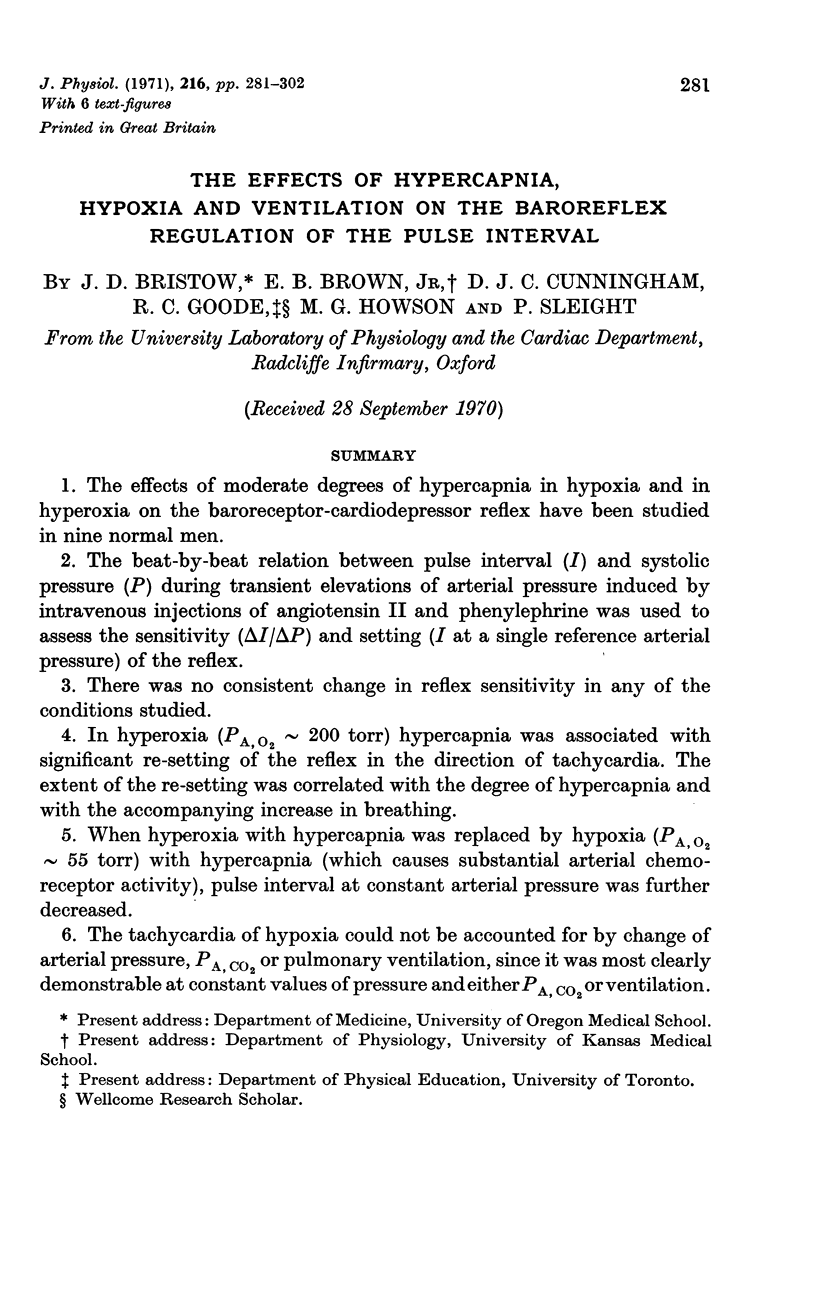
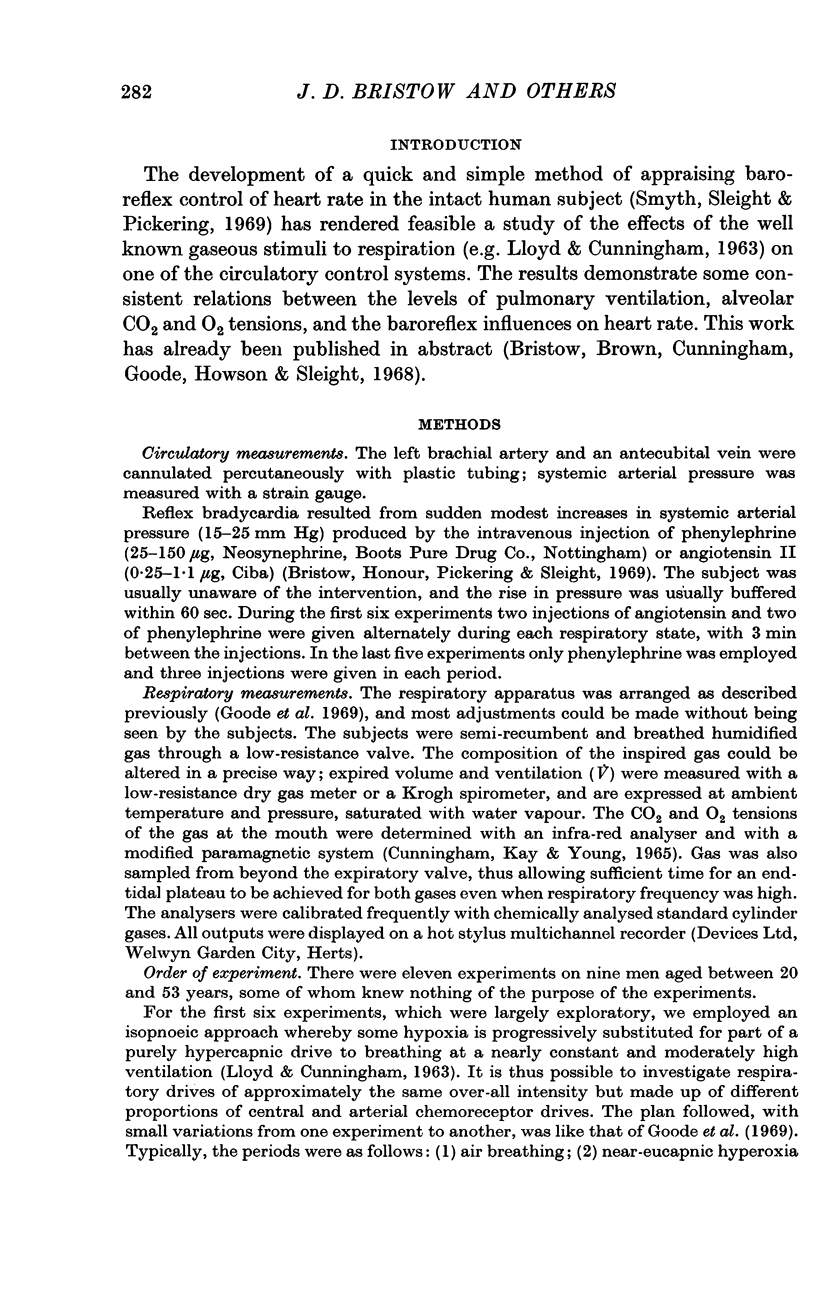








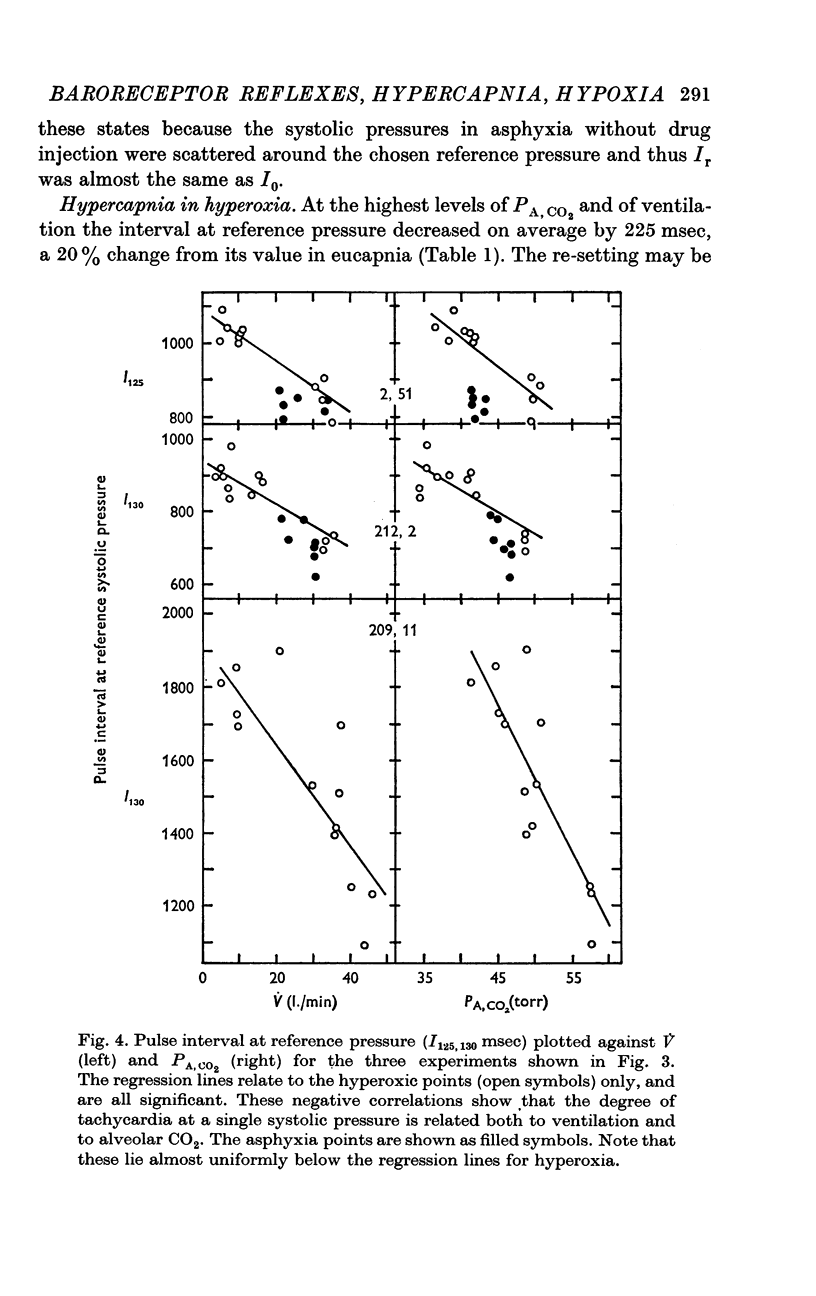






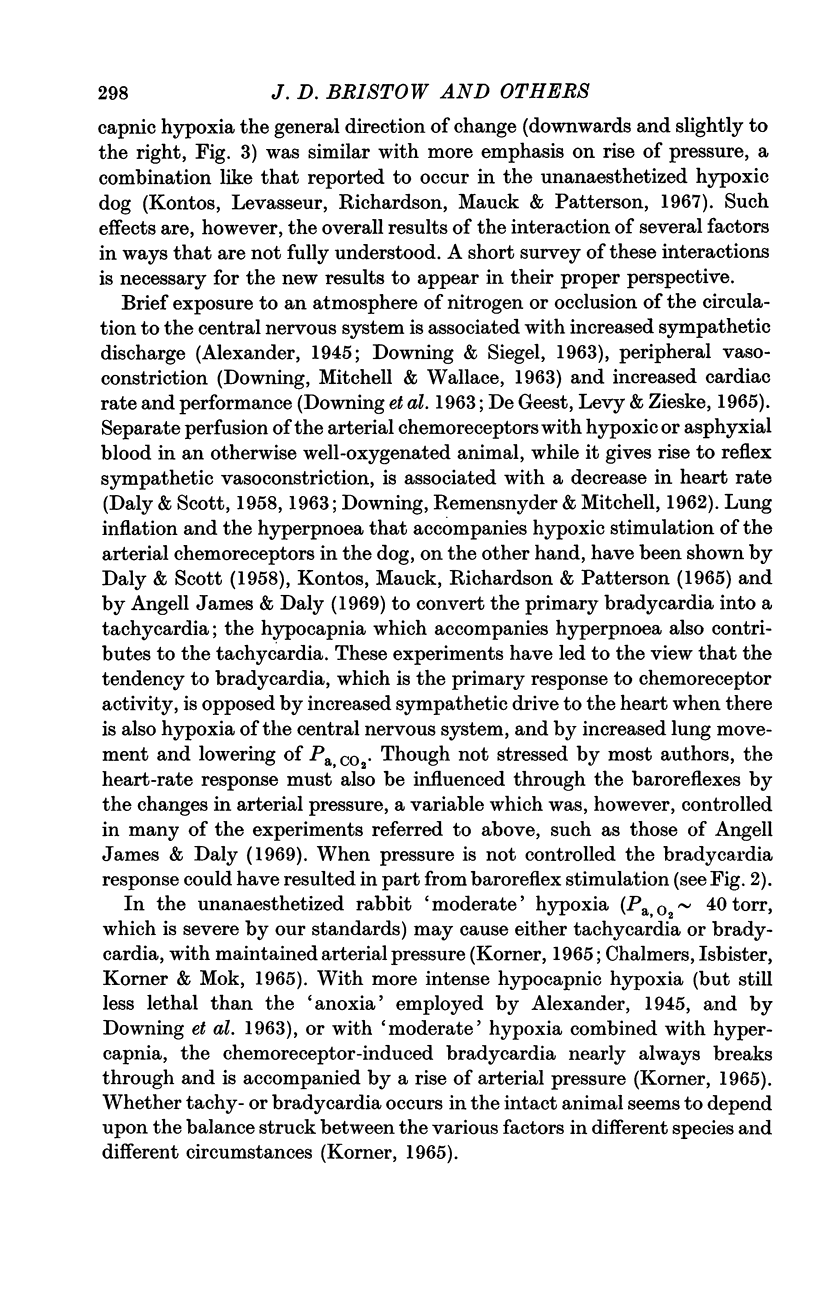

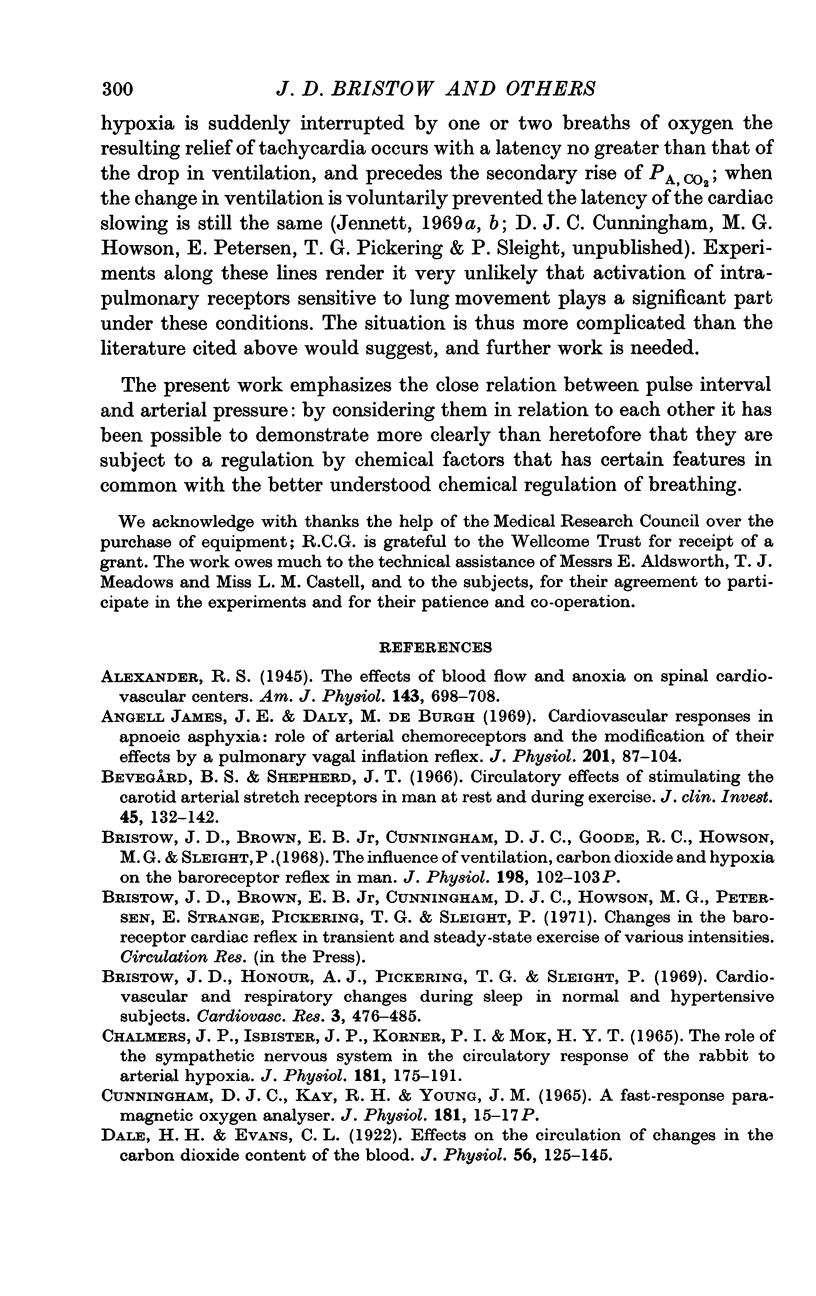

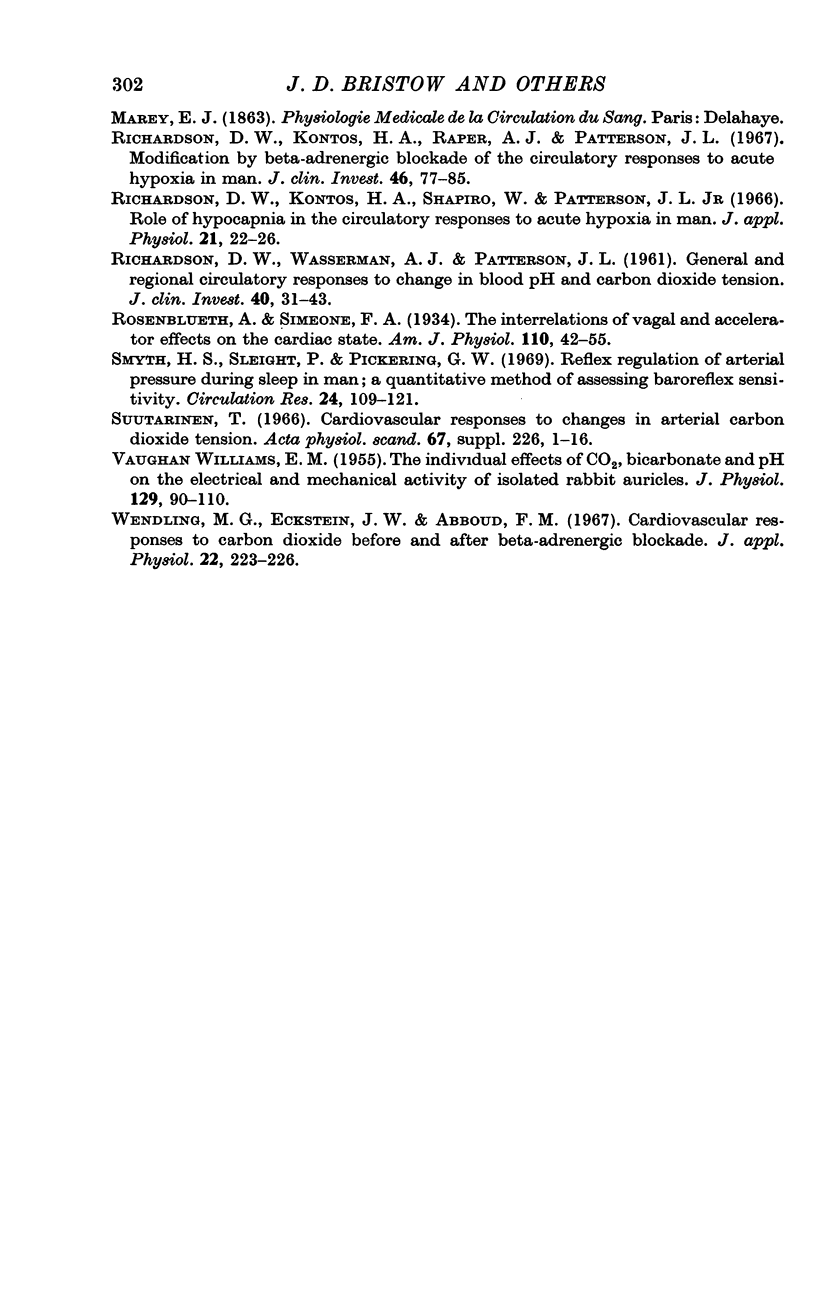
Selected References
These references are in PubMed. This may not be the complete list of references from this article.
- Bevegård B. S., Shepherd J. T. Circulatory effects of stimulating the carotid arterial stretch receptors in man at rest and during exercise. J Clin Invest. 1966 Jan;45(1):132–142. doi: 10.1172/JCI105317. [DOI] [PMC free article] [PubMed] [Google Scholar]
- Bristow J. D., Honour A. J., Pickering T. G., Sleight P. Cardiovascular and respiratory changes during sleep in normal and hypertensive subjects. Cardiovasc Res. 1969 Oct;3(4):476–485. doi: 10.1093/cvr/3.4.476. [DOI] [PubMed] [Google Scholar]
- Chalmers J. P., Isbister J. P., Korner P. I., Mok H. Y. The role of the sympathetic nervous system in the circulatory response of the rabbit to arterial hypoxia. J Physiol. 1965 Nov;181(1):175–191. doi: 10.1113/jphysiol.1965.sp007753. [DOI] [PMC free article] [PubMed] [Google Scholar]
- DE DALY M. B., SCOTT M. J. The effects of stimulation of the carotid body chemoreceptors on heart rate in the dog. J Physiol. 1958 Nov 10;144(1):148–166. doi: 10.1113/jphysiol.1958.sp006092. [DOI] [PMC free article] [PubMed] [Google Scholar]
- DEJOURS P., LABROUSSE Y., RAYNAUD J., GIRARD F., TEILLAC A. Stimulus oxygène de la ventilation au repos et au cours de l'exercice musculaire, à basse altitude (50 m), chez l'homme. Rev Fr Etud Clin Biol. 1958 Feb;3(2):105–123. [PubMed] [Google Scholar]
- DOWNING S. E., REMENSNYDER J. P., MITCHELL J. H. Cardiovascular responses to hypoxic stimulation of the carotid bodies. Circ Res. 1962 Apr;10:676–685. doi: 10.1161/01.res.10.4.676. [DOI] [PubMed] [Google Scholar]
- Dale H. H., Evans C. L. Effects on the circulation of changes in the carbon-dioxide content of the blood. J Physiol. 1922 May 16;56(3-4):125–145. doi: 10.1113/jphysiol.1922.sp001997. [DOI] [PMC free article] [PubMed] [Google Scholar]
- DeGeest H., Levy M. N., Zieske H. Reflex effects of cephalic hypoxia, hypercapnia, and ischemia upon ventricular contractility. Circ Res. 1965 Oct;17(4):349–358. doi: 10.1161/01.res.17.4.349. [DOI] [PubMed] [Google Scholar]
- GOLDRING R. M., TURINO G. M., COHEN G., JAMESON A. G., BASS B. G., FISHMAN A. P. The catecholamines in the pulmonary arterial pressor response to acute hypoxia. J Clin Invest. 1962 Jun;41:1211–1221. doi: 10.1172/JCI104582. [DOI] [PMC free article] [PubMed] [Google Scholar]
- Goode R. C., Brown E. B., Jr, Howson M. G., Cunningham D. J. Respiratory effects of breathing down a tube. Respir Physiol. 1969 Apr;6(3):343–359. doi: 10.1016/0034-5687(69)90033-4. [DOI] [PubMed] [Google Scholar]
- HARRIS P., BISHOP J. M., SEGEL N. The influence of guanethidine on hypoxic pulmonary hypertension in normal man. Clin Sci. 1961 Dec;21:295–300. [PubMed] [Google Scholar]
- HUTTER O. F., TRAUTWEIN W. Vagal and sympathetic effects on the pacemaker fibers in the sinus venosus of the heart. J Gen Physiol. 1956 May 20;39(5):715–733. doi: 10.1085/jgp.39.5.715. [DOI] [PMC free article] [PubMed] [Google Scholar]
- James J. E., Daly M. de B. Cardiovascular responses in apnoeic asphyxia: role of arterial chemoreceptors and the modification of their effects by a pulmonary vagal inflation reflex. J Physiol. 1969 Mar;201(1):87–104. doi: 10.1113/jphysiol.1969.sp008744. [DOI] [PMC free article] [PubMed] [Google Scholar]
- Jennett S. Changes in ventilation and heart rate during and after brief moderate hypoxia in resting man. J Physiol. 1969 Feb;200(2):106P–107P. [PubMed] [Google Scholar]
- Jennett S. The effect of brief moderate hypoxia and abrupt re-oxygenation on the heart rate in human subjects with cervical spinal transection. J Physiol. 1969 Nov;205(2):35P–36P. [PubMed] [Google Scholar]
- KONTOS H. A., MAUCK H. P., Jr, RICHARDSON D. W., PATTERSON J. L., Jr MECHANISM OF CIRCULATORY RESPONSES TO SYSTEMIC HYPOXIA IN THE ANESTHETIZED DOG. Am J Physiol. 1965 Aug;209:397–403. doi: 10.1152/ajplegacy.1965.209.2.397. [DOI] [PubMed] [Google Scholar]
- Kontos H. A., Levasseur J. E., Richardson D. W., Mauck H. P., Jr, Patterson J. L., Jr Comparative circulatory responses to systemic hypoxia in man and in unanesthetized dog. J Appl Physiol. 1967 Sep;23(3):381–386. doi: 10.1152/jappl.1967.23.3.381. [DOI] [PubMed] [Google Scholar]
- Korner P. I. The role of the arterial chemoreceptors and baroreceptors in the circulatory response to hypoxia of the rabbit. J Physiol. 1965 Sep;180(2):279–303. doi: 10.1113/jphysiol.1965.sp007703. [DOI] [PMC free article] [PubMed] [Google Scholar]
- Korner P. I., White S. W. Circulatory control in hypoxia by the sympathetic nerves and adrenal medulla. J Physiol. 1966 May;184(2):272–290. doi: 10.1113/jphysiol.1966.sp007915. [DOI] [PMC free article] [PubMed] [Google Scholar]
- Loeschcke H. H., De Lattre J., Schläfke M. E., Trouth C. O. Effects on respiration and circulation of electrically stimulating the ventral surface of the medulla oblongata. Respir Physiol. 1970 Sep;10(2):184–197. doi: 10.1016/0034-5687(70)90082-4. [DOI] [PubMed] [Google Scholar]
- RICHARDSON D. W., WASSERMAN A. J., PATTERSON J. L., Jr General and regional circulatory responses to change in blood pH and carbon dioxide tension. J Clin Invest. 1961 Jan;40:31–43. doi: 10.1172/JCI104234. [DOI] [PMC free article] [PubMed] [Google Scholar]
- Richardson D. W., Kontos H. A., Raper A. J., Patterson J. L., Jr Modification by beta-adrenergic blockade of the circulatory respones to acute hypoxia in man. J Clin Invest. 1967 Jan;46(1):77–85. doi: 10.1172/JCI105513. [DOI] [PMC free article] [PubMed] [Google Scholar]
- Richardson D. W., Kontos H. A., Shapiro W., Patterson J. L., Jr Role of hypocapnia in the circulatory responses to acute hypoxia in man. J Appl Physiol. 1966 Jan;21(1):22–26. doi: 10.1152/jappl.1966.21.1.22. [DOI] [PubMed] [Google Scholar]
- Smyth H. S., Sleight P., Pickering G. W. Reflex regulation of arterial pressure during sleep in man. A quantitative method of assessing baroreflex sensitivity. Circ Res. 1969 Jan;24(1):109–121. doi: 10.1161/01.res.24.1.109. [DOI] [PubMed] [Google Scholar]
- VAUGHAN WILLIAMS E. M. The individual effects of CO2, bicarbonate and pH on the electrical and mechanical activity of isolated rabbit auricles. J Physiol. 1955 Jul 28;129(1):90–110. doi: 10.1113/jphysiol.1955.sp005340. [DOI] [PMC free article] [PubMed] [Google Scholar]
- Wendling M. G., Eckstein J. W., Abboud F. M. Cardiovascular responses to carbon dioxide before and after beta-adrenergic blockade. J Appl Physiol. 1967 Feb;22(2):223–226. doi: 10.1152/jappl.1967.22.2.223. [DOI] [PubMed] [Google Scholar]


